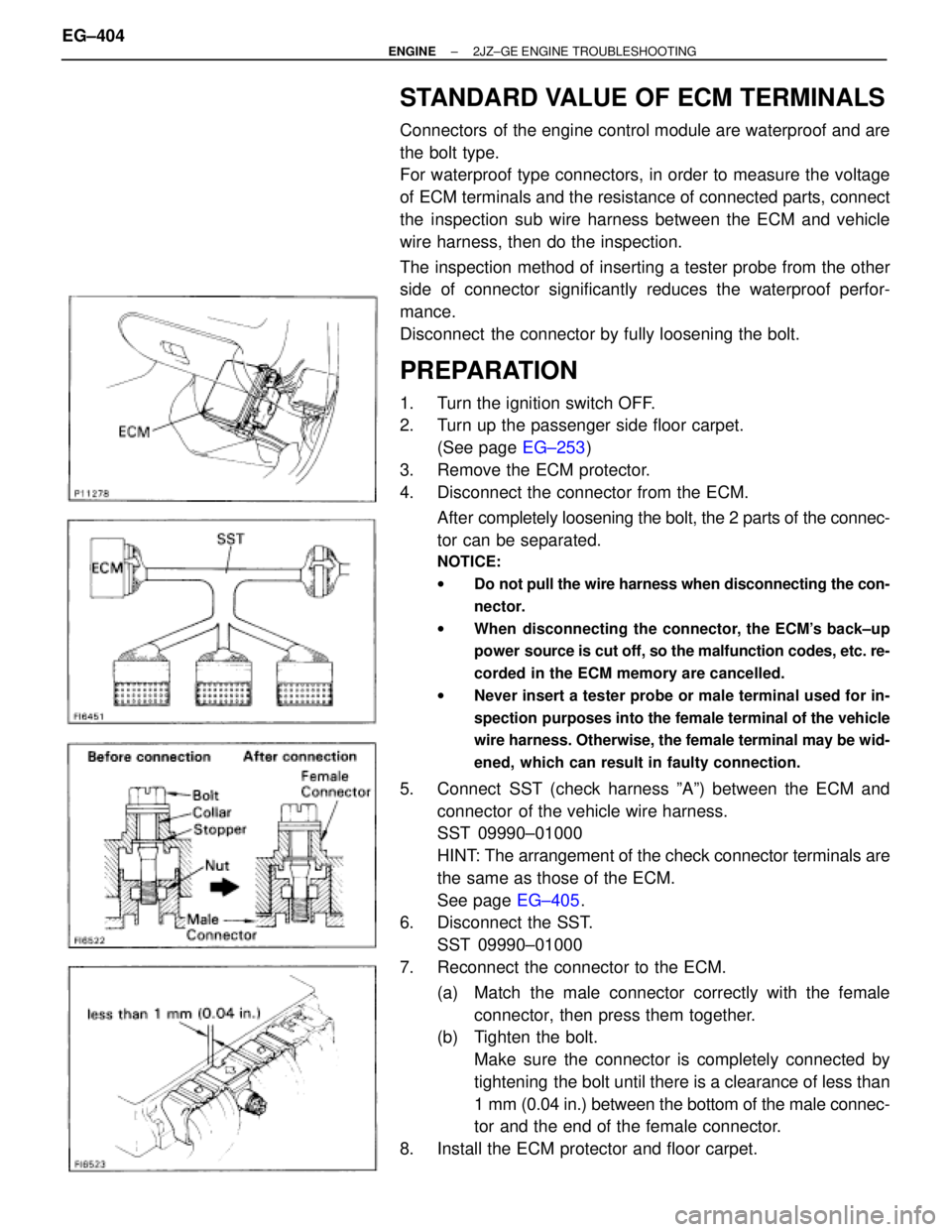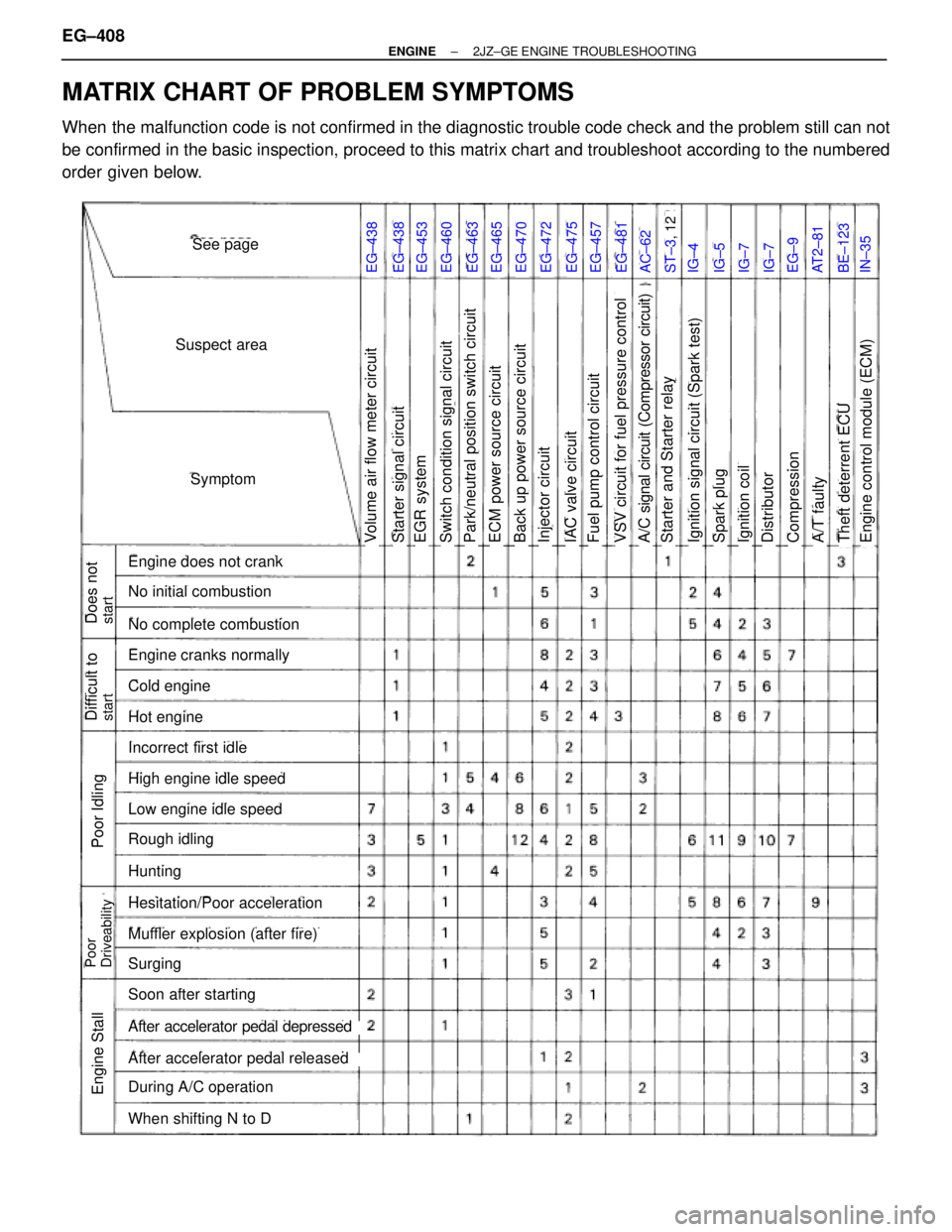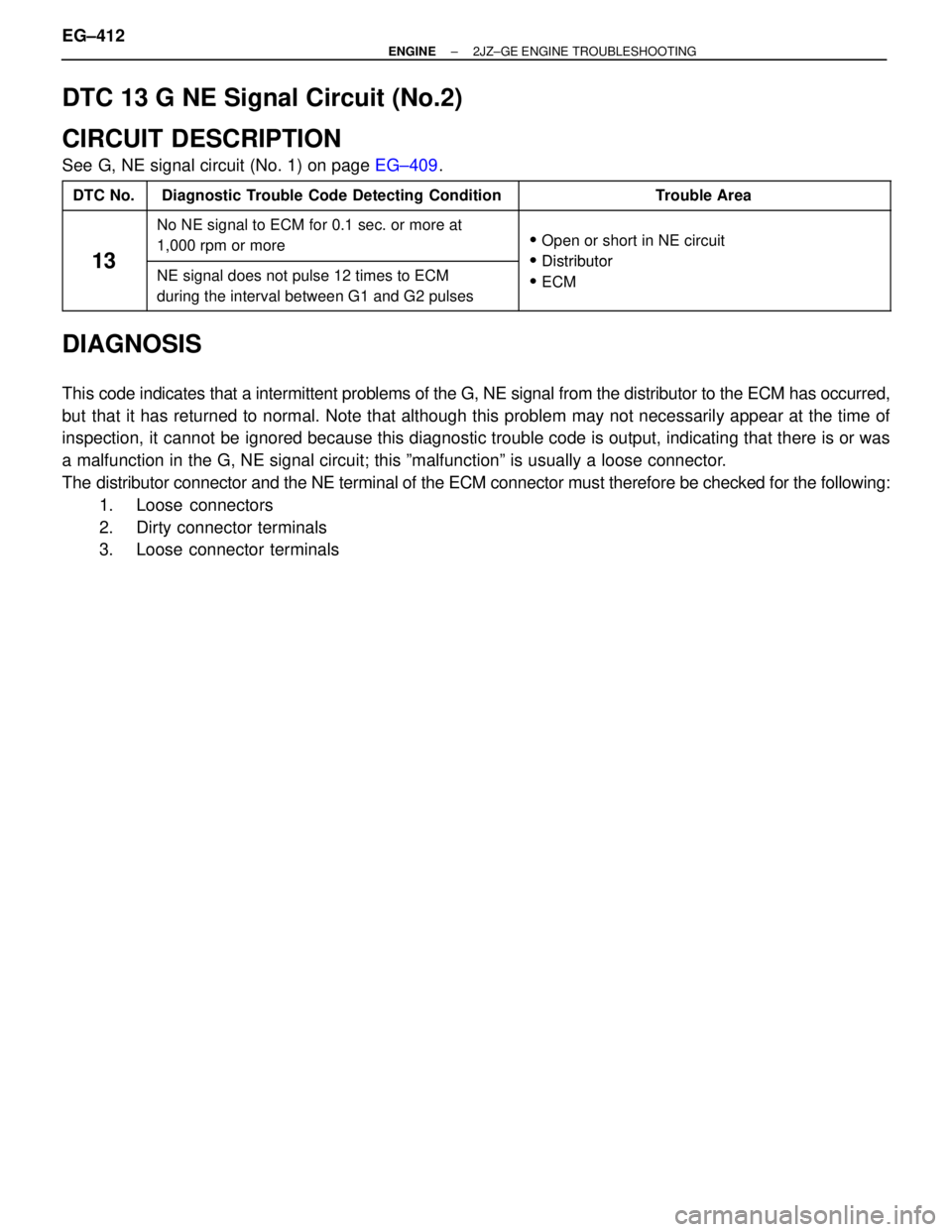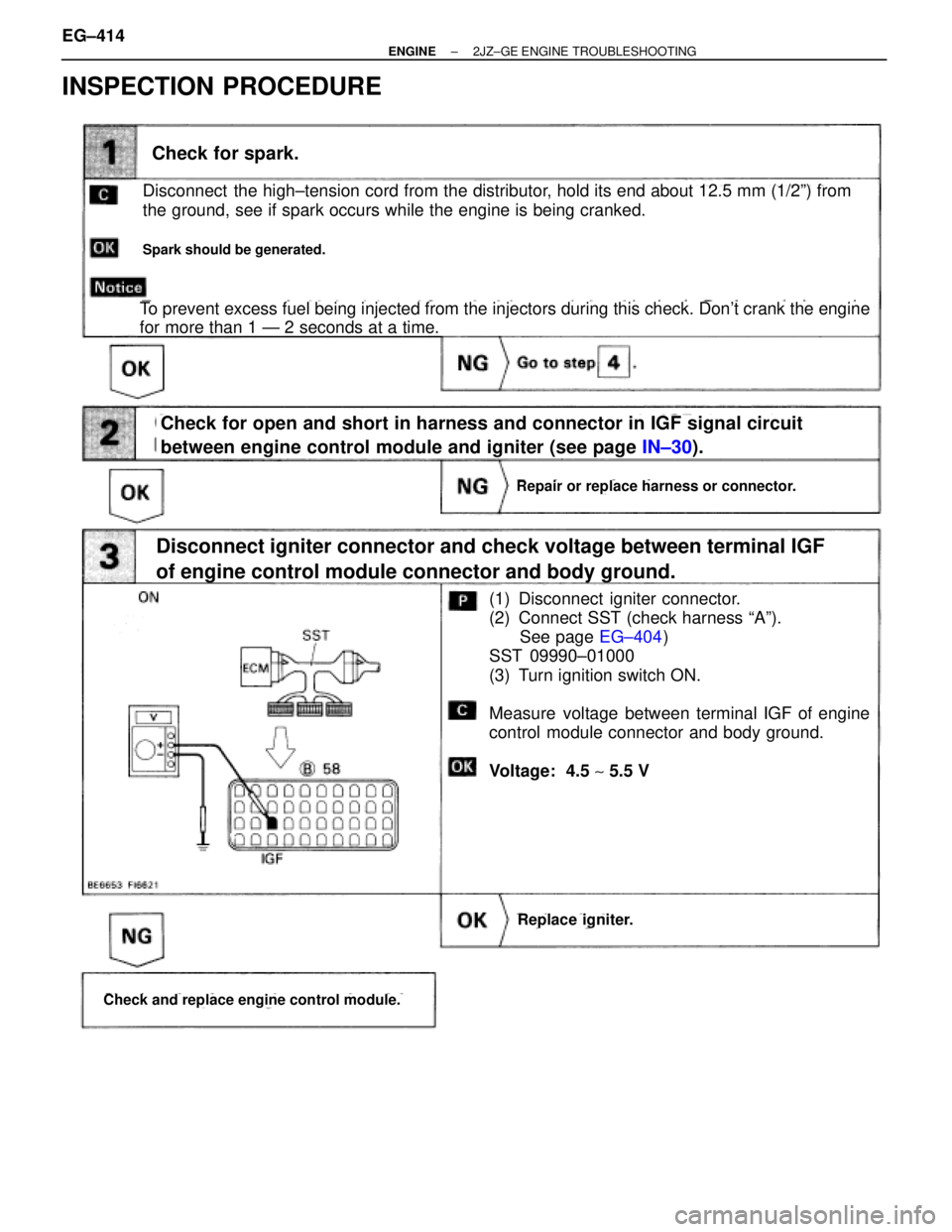Page 160 of 878

STANDARD VALUE OF ECM TERMINALS
Connectors of the engine control module are waterproof and are
the bolt type.
For waterproof type connectors, in order to measure the voltage
of ECM terminals and the resistance of connected parts, connect
the inspection sub wire harness between the ECM and vehicle
wire harness, then do the inspection.
The inspection method of inserting a tester probe from the other
side of connector significantly reduces the waterproof perfor-
mance.
Disconnect the connector by fully loosening the bolt.
PREPARATION
1. Turn the ignition switch OFF.
2. Turn up the passenger side floor carpet.
(See page EG±253)
3. Remove the ECM protector.
4. Disconnect the connector from the ECM.
After completely loosening the bolt, the 2 parts of the connec-
tor can be separated.
NOTICE:
wDo not pull the wire harness when disconnecting the con-
nector.
wWhen disconnecting the connector, the ECM's back±up
power source is cut off, so the malfunction codes, etc. re-
corded in the ECM memory are cancelled.
wNever insert a tester probe or male terminal used for in-
spection purposes into the female terminal of the vehicle
wire harness. Otherwise, the female terminal may be wid-
ened, which can result in faulty connection.
5. Connect SST (check harness ºAº) between the ECM and
connector of the vehicle wire harness.
SST 09990±01000
HINT: The arrangement of the check connector terminals are
the same as those of the ECM.
See page EG±405.
6. Disconnect the SST.
SST 09990±01000
7. Reconnect the connector to the ECM.
(a) Match the male connector correctly with the female
connector, then press them together.
(b) Tighten the bolt.
Make sure the connector is completely connected by
tightening the bolt until there is a clearance of less than
1 mm (0.04 in.) between the bottom of the male connec-
tor and the end of the female connector.
8. Install the ECM protector and floor carpet. EG±404
± ENGINE2JZ±GE ENGINE TROUBLESHOOTING
Page 164 of 878

MATRIX CHART OF PROBLEM SYMPTOMS
When the malfunction code is not confirmed in the diagnostic trouble code check and the problem still can not
be confirmed in the basic inspection, proceed to this matrix chart and troubleshoot according to the numbered
order given below.
EG±438EG±438EG±453EG±460EG±463EG±465EG±470EG±472EG±475EG±457EG±481AC±62ST±3, 12IG±4IG±5IG±7IG±7EG±9AT2±81BE±123IN±35
See page
Suspect area
Symptom
Engine does not crank
No initial combustion
No complete combustion
Engine cranks normally
Cold engine
Hot engine
Incorrect first idle
High engine idle speed
Low engine idle speed
Rough idling
Hunting
Hesitation/Poor acceleration
Muffler explosion (after fire)
Surging
Soon after starting
After accelerator pedal depressed
After accelerator pedal released
During A/C operation
When shifting N to D
Does notstart
Difficult tostart
Poor Idling
Poor
Driveability
Engine Stall
Volume air flow meter circuitECM power source circuitPark/neutral position switch circuitSwitch condition signal circuitEGR systemStarter signal circuitStarter and Starter relayA/C signal circuit (Compressor circuit)VSV circuit for fuel pressure controlFuel pump control circuitIAC valve circuitInjector circuitBack up power source circuitIgnition coilSpark plugIgnition signal circuit (Spark test)CompressionA/T faultyDistributorEngine control module (ECM)Theft deterrent ECU
EG±408± ENGINE2JZ±GE ENGINE TROUBLESHOOTING
Page 166 of 878
INSPECTION PROCEDURE
Check resistance of each pickup coils in distributor.
INSPECTION USING OSCILLOSCOPE
Replace Distributor
Repair or replace harness or connector
Check for open and short in harness and connector between engine control
module and distributor (See page IN±30).
Disconnect distributor connector.
Measure resistance between each terminal shown
in the table below.
ªColdº is from Ð 10°C (14°F) to 50°C (122°F)
and ªHotº is from 50°C (122°F) to 100°C
(212°F).
wDuring cranking or idling, check waveforms between
terminals G1, G2, NE and G � of engine control
module
HINT: The correct waveforms are as shown.
G1 pickup coil
G2 pickup coil
NE pickup coil
(NE±G �)
(G1±G �)
(G2±G �)
Resistance
EG±410± ENGINE2JZ±GE ENGINE TROUBLESHOOTING
Page 167 of 878
Check air gap.
Remove distributor cap & rotor.
Using SST (G1 and G2 pickups) and a thickness gauge
(NE pickup), measure the air gap between the signal ro-
tor and pickup coil projection.
SST 09240±00020 for G1 and G2 pickups
Air gap: 0.2 Ð 0.5 mm (0.008 Ð 0.020 in.)
Replace distributor housing assembly
Check and replace engine control module.
± ENGINE2JZ±GE ENGINE TROUBLESHOOTINGEG±411
Page 168 of 878

DTC 13 G NE Signal Circuit (No.2)
CIRCUIT DESCRIPTION
See G, NE signal circuit (No. 1) on page EG±409.
����� �����DTC No.���������������� ����������������Diagnostic Trouble Code Detecting Condition����������������� �����������������Trouble Area����� �
���� �����
13
���������������� �
��������������� ���������������� No NE signal to ECM for 0.1 sec. or more at
1,000 rpm or more����������������� �
���������������� ������������������ Open or short in NE circuit
�Distributor����� �
���� �
���� �����
13���������������� �
��������������� �
��������������� ����������������
NE signal does not pulse 12 times to ECM
during the interval between G1 and G2 pulses
����������������� �
���������������� �
���������������� �����������������
� Distributor
� ECM
DIAGNOSIS
This code indicates that a intermittent problems of the G, NE signal from the distributor to the ECM has occurred,
but that it has returned to normal. Note that although this problem may not necessarily appear at the time of
inspection, it cannot be ignored because this diagnostic trouble code is output, indicating that there is or was
a malfunction in the G, NE signal circuit; this ºmalfunctionº is usually a loose connector.
The distributor connector and the NE terminal of the ECM connector must therefore be checked for the following:
1. Loose connectors
2. Dirty connector terminals
3. Loose connector terminals EG±412
± ENGINE2JZ±GE ENGINE TROUBLESHOOTING
Page 170 of 878

INSPECTION PROCEDURE
(See page IN±30).
(See page EG±404)
Check for spark.
Disconnect the high±tension cord from the distributor, hold its end about 12.5 mm (1/2º) from
the ground, see if spark occurs while the engine is being cranked.
Spark should be generated.
To prevent excess fuel being injected from the injectors during this check. Don't crank the engine
for more than 1 Ð 2 seconds at a time.
Check for open and short in harness and connector in IGF signal circuit
between engine control module and igniter (see page IN±30).
Disconnect igniter connector and check voltage between terminal IGF
of engine control module connector and body ground.
Repair or replace harness or connector.
Replace igniter.
Check and replace engine control module.
(1) Disconnect igniter connector.
(2) Connect SST (check harness ªAº).
See page EG±404)
SST 09990±01000
(3) Turn ignition switch ON.
Measure voltage between terminal IGF of engine
control module connector and body ground.
Voltage: 4.5 ~ 5.5 V EG±414
± ENGINE2JZ±GE ENGINE TROUBLESHOOTING
Page 171 of 878
Connect SST (check harness ªAº).
See page EG±404)
SST 09990±01000
Measure voltage between terminal IGF of engine
control module connector and body ground when
engine is cranked.
Voltage: 0.5 Ð 1.0 V
(Neither 0 V nor 5 V)
Check voltage between terminal IGT of engine control module connector and
body ground.
INSPECTION USING OSCILLOSCOPE
�During cranking or idling, check waveforms between
terminal IGT and E1 of engine control module.
HINT: The correct rectangular waveforms are as shown.
Check voltage between terminal 3 of igniter connector and body ground.
Disconnect igniter connector.
Measure voltage between terminal 3 of igniter
connector and body ground, when ignition switch
is turned to ªONº and ªSTARTº position.
Voltage: 9 Ð 14 V
Check and repair igniter power source circuit.
± ENGINE2JZ±GE ENGINE TROUBLESHOOTINGEG±415
Page 172 of 878
Check ignition coil.
Disconnect ignition coil connector.
(1) Check primary coil.
Measure resistance between terminals of ignition coil
connector.
(2) Check secondary coil.
Measure resistance between terminal � of ignition coil
connector and high±tension terminal.
Repair or replace harness or connector.
Check for open and short in harness and connector between ignitioin switch
and ignition coil, ignition coil and igniter (See page
IN±30).
ªColdº is from Ð 10°C (14°F) to 50°C (122°F) and
ªHotº is from 50°C (122°F) to 100°C (212°F).
Replace ignition coil.
Replace igniter.
Resistance
Primary Coil
Secondary
Coil
EG±416± ENGINE2JZ±GE ENGINE TROUBLESHOOTING